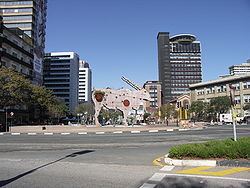Postal code (street) 2001 Area code 010 | Established 1853 Area 3.28 km² PO box 2017 | |
 | ||
Mzansi style guide vol 1 braamfontein scene
Braamfontein (English: blackberry fountain) is a central suburb of Johannesburg, in South Africa. Braamfontein is part of a cultural arc that includes Newtown, the University of the Witwatersrand, Constitution Hill and the Civic Centre. The Nelson Mandela Bridge is a landmark that connects Braamfontein to the city centre. Jan Smuts Avenue and Empire Road are two major thoroughfares that run through the suburb.
Contents
- Mzansi style guide vol 1 braamfontein scene
- Map of Braamfontein Johannesburg 2001 South Africa
- Biting about s01e04 braamfontein 2016
- History
- Arts and entertainment
- References
Map of Braamfontein, Johannesburg, 2001, South Africa
Biting about s01e04 braamfontein 2016
History
The name "Braamfontein" dates from as early as 1853, when a farm with this name to the north-west of Randjeslaagte belonged to Gert Bezuidenhout. In that year he applied to the government to have his farm surveyed. Five years later, in 1858, Gert sold his farm to F.J. Bezuidenhout.
Like many farms on the Witwatersrand, Braamfontein was subdivided early on, indicating a fairly dense population in the area. Two other Bezuidenhouts, Gerhardus Petrus and Cornelis Willem, each purchased one third of the farm in 1862, and a third part went to Frans Johannes van Dijk. Between 1862 and 1886 different portions were further subdivided, at escalating prices.
Three other well-known owners were Johannes Jacobus Lindeque, who in 1884, bought a section where the Country Club was later established in 1906, and Frans Eduard and Louwrens Geldenhuys.
The first suburb established on the farm Braamfontein in 1888-1889 was unofficially named after the farm, as an official extension of the city of Johannesburg. This area is still called Braamfontein. There was, however, an earlier but unsuccessful effort to create a suburb prior to this.
On February 19, 1896, a train containing 56 tonnes of dynamite exploded in Braamfontein, killing 78 people.
During the apartheid era, large-scale commercial development in the area was encouraged. After the abolition of apartheid, the area began to deteriorate. However, intervention by both the city of Johannesburg and large corporate business, acting as the "Braamfontein Management District", initiated a process of urban renewal in this inner-city district. Urban renewal efforts and the establishment of the Braamfontein Management District by the Johannesburg Development Agency and property owners have led to the district's regeneration as a corporate district, educational centre, and entertainment and arts hub.
Situated north of the city centre, Braamfontein is the fourth-largest node supplying office space in the city of Johannesburg. The Nelson Mandela Bridge links Newtown and Braamfontein to form a "Cultural Arc". Several South African-based multinational companies have their offices here.
The offices of the Johannesburg City Council and the University of the Witwatersrand are located in Braamfontein.
Arts and entertainment
Braamfontein is a prominent centre in Nyoso Johannesburg for arts and entertainment and hosts many of South Africa's musicians and artists. The Joburg Theatre is one of the country's prime theatres, has a daily visitor count of 1,200 people and houses the Nelson Mandela Theatre.
The National School of the Arts is also situated in Braamfontein as is the not-for-profit organization Southern African Music Rights Organisation (SAMRO), which protects the intellectual property of music creators by licensing music users, collecting licence fees and distributing royalties to music creators.
